Home | Front Page | Blog | Index | New | Contact | Site Map
![]() Japan
Japan
![]() Nagoya
Nagoya
![]() Takayama
Takayama
![]() Gifu
Gifu
![]() Kanazawa
Kanazawa
![]() Kyoto
Kyoto
![]() Shikoku
Shikoku
![]() Henro Pilgrimage
Henro Pilgrimage
Cherry Blossoms
Shrines and Temples
Museums
Bicycling
Kabuki Theater
Food and Lodging
Shibuya
Shinjuku
Yokohama
Narita Town

Travel 2008
Australia
Britain
Paris
Basel
Berlin
Travel 2007
Sydney
Paris
Britain
USA
Canada
Australia 2007-08
Travel 2006
Greece
Turkey
Thailand
Malaysia
Indonesia
Singapore
Travel 2005
Berlin
Paris
Moscow
Russia
Athens

Nagoya Hirokoji Dori |
Nagoya was the great discovery for us in this trip to Japan: we went there because it was a way of getting to Takayama which was said to have some of the best preserved ancient streets in Japan. Surprisingly, because the discount bus company Willer Express went there, it was cheaper to go via Nagoya than take the more direct route. Great! A big bird (Nagoya) and a small bird (Takayama) for the price of 1.5 birds.
Willer Bus: Tokyo to Nagoya
Willer bus departs from Shinjuku, the Manhattan (or one of the Manhattans) of Tokyo, and on a direct local bus from near us in Shibuya. Days before our departure for Nagoya we went to Willer and found the address but didn't find the Willer office. On our last Tokyo morning we left our apartment at about 6:30 am, to be sure to catch the bus to Shinjuku that would give us time to find our Willer bus company and therefore our bus. Although it sounds easy, it never really is. The bus company office and waiting room were in the basement of a 50+ story office building. But the buses of course left from the parking lot on the ground floor. As we trundled our bags down an escalator, we didn't realize that getting from the waiting room to the bus would involve climbing a flight of stairs! Why not go back up the escalator, one might ask? Because Willer wanted to act like an airline company, with passenger check-in through a turnstile, except that the only way to the parking lot once through the turnstile was via a basement courtyard and, you guessed it, a flight of steps. Even though some bright spark sent a young man to help carry our bags up the stairs, we were still very bemused at this way of doing things. It would have been so much easier to check tickets at the entrance to the bus so that we could use the escalators.
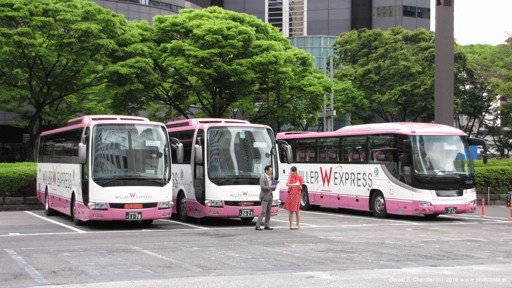
Willer Bus |
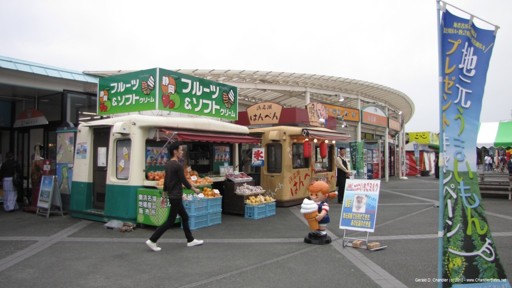
Rest Stop |
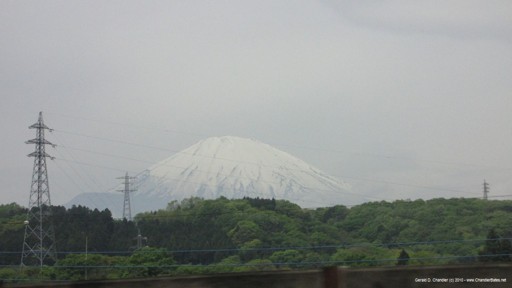
Fuji View from Bus |
In less than an hour we were off and about to get our first chance to see Japan outside of Tokyo. But it didn't quite work out that way. We'd hardly gone a few miles when we got onto an elevated expressway and found we could see — almost nothing. Almost every expressway in Japan has high-walled noise shields that keep one from seeing much of anything. That's the way we missed most of Yokohama and a lot of Tokyo bay as we sped south-west. As we neared Numazu, about 75 miles from Tokyo and 1/3 of the way to Nagoya, a miracle occurred: The noise barriers faded away, we saw a bit of country side, and then, wonderful, five minutes of Mt Fuji, not at all encumbered by clouds. Shortly thereafter we had a break — was it a toilet break or a food break? &mdash at a highway stop. Judging from what was on sale it was a break to buy the gift that custom requires for any traveling Japanese. From the highway stop we got even better views of Fuji and then more and better views in the next few miles. After that noise barriers and tunnels insured that we saw little more until we left the expressway and entered Nagoya's city streets.

Nagoya Station District |
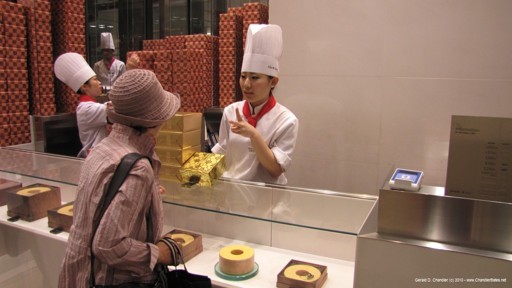
German Cakes Made in Japan |
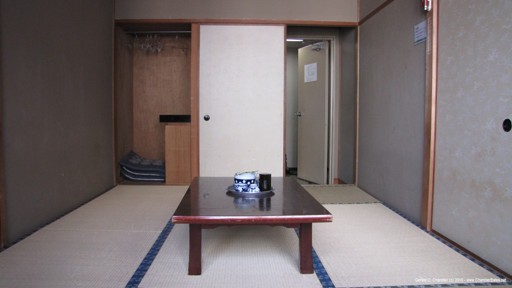
Eight Tatami Hostel Room |
We knew little about what we would see in Nagoya before getting there; we knew it was a big city but not that it is the fourth largest metropolitan area. Jan is always a bit nervous when travelling to a new place and likes where possible to pre-book a room so that we have a real destination on arrival. Over the web, we found a youth hostel in Nagoya and booked ourselves in for three nights. It was a bit of a walk from the central station where Willer dropped us off, but we managed it even with our bags. The walk was made a tiny bit longer because we initially were turned around and went the wrong way. Ultimately we turned back and walked through the station; that gave us the chance to find the tourist office and get a bus map and discover the many shops there, including one that made German-style cakes and had a long line of people waiting to buy them straight from the oven (or rather, the cake-making machine).
The hostel lobby was a bit spartan-looking and the corridor to our room very institutional, so we were absolutely delighted to find ourselves in an 8-mat tatami room with an unobscured view of the nearby river. The toilets were down the hall and a Japanese bath two floors up. It was our first experience of Japanese baths on this trip, as we had had a modern shower in the apartment in Tokyo, and we quickly grew to love them again.
For the uninitiated, the Japanese bath is meant for soaking once the body is clean. The bath water, which is kept at a high temperature, is drawn once and used by everyone. Bathers are expected to wash thoroughly in the tiled area around the bath before climbing into the bath. Bathers are provided with low stools to sit on, hand-held showers and/or bowls for rinsing, as well as soap and shampoo. The bath is often covered to keep it warm and the cover must therefore be removed and then replaced after use. Most hotels provide a yukata, a cotton bathrobe for use after the bath. We fell in love with yukatas on our first trip to Japan and have almost always managed to own one each since then. We got new ones while in Tokyo on this trip.
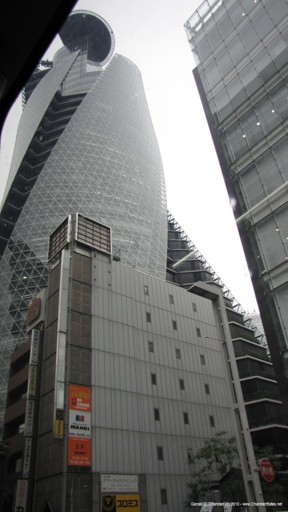
Office Tower |
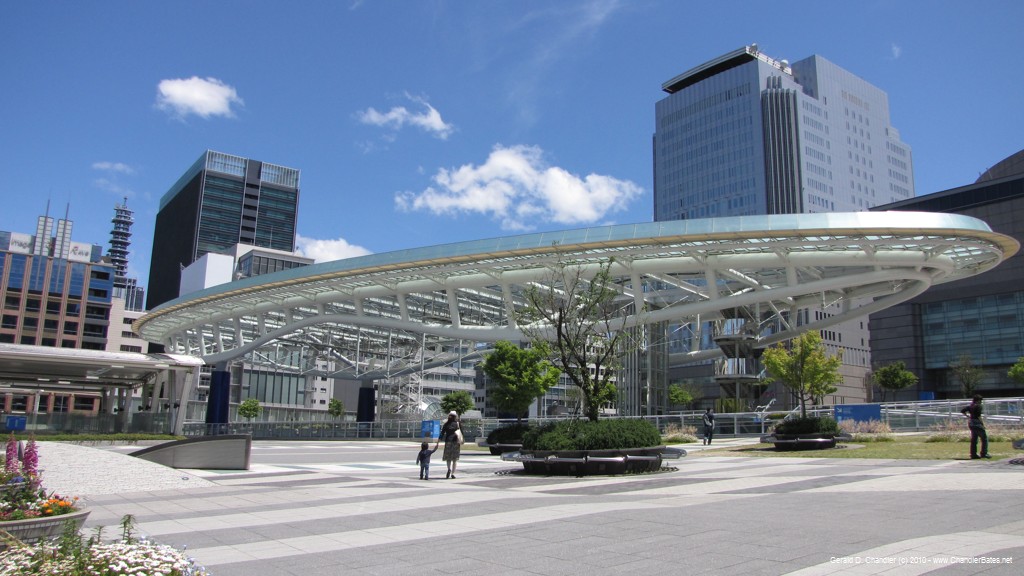
Oasis 21 Bus Terminal |

Nagoya Port Bridge |
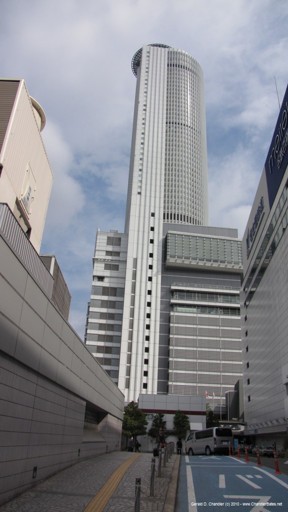
Office Tower |
Unbeknownst to us we were on the edge of Nagoya's equivalent to Tokyo's Ginza. Nearby there were plenty of brightly lit restaurants with traditional floor seating and modern chair seating. We ended up liking not only our room in Nagoya, but the city itself and so extended our stay here from three nights to six. During that time we rode a lot of buses and walked all over the center. We found there were two personalities to Nagoya: one was bright and modern; it has a tremendous collection of modern, glass walled buildings. And it has a strong presence of the Japanese past with colorful temples and its old castle.
Nagoya Castle and Noh Theater
Nagoya Castle Donjon |
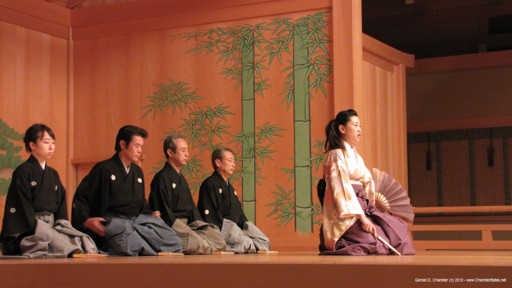
Noh Theater |

Noh Theater |
Ask what you should see in Nagoya and you are sure to be told Nagoya castle and its museum. We put off going there for a day because we wanted to wait for a sunny day. That was a good choice. The castle looked so photogenic in the sun and although the gardens were not very colorful yet, they still looked more attractive in sunshine. The castle museum was most interesting. A combination of local history and folk culture was laid out on three floors and kept us happily occupied for a good three hours. Nonetheless we were disappointed with the inside because we wanted to see what a traditional castle was like — and that had been gone since the Meiji Restoration. (Six weeks later we got to see a castle that was still largely intact in Kochi on Shikoku Island)
On leaving the castle, we noticed a quite imposing building opposite and went to explore. It turned out to be a theater dedicated to the Noh drama, the Nohgaku-Do. We had both seen Noh performed on our first trip to Japan. We know it was outdoors somewhere and think it must have been somewhere in Kyoto, but aren't sure any more. Jan also got to see Noh in an indoor theater during her 1986 trip to Japan courtesy of one of her fellow-guests at the YWHA where she lived for most of her ten-week stay. Needless to say we were quite interested to look at the theater and inquired about performances. To our great satisfaction, we learned that there would be a whole day of free Noh performances that weekend. We extended our stay so that we could go along and were delighted with what we saw.
We didn't understand until after several hours on the day of the performances that they were an end-of-year performance presented by a private school that specialized in Noh drama. We watched the entire day's performance, which consisted of extracts from famous dramas much like we had seen at the Meiji shrine in Tokyo. As we left the theater at the end of the day, we met a Japanese couple, who asked how we had enjoyed it. When we expressed our pleasure, they reciprocated indicating that they were the owners of the school! They seemed especially pleased to have had foreigners in the audience.
Atsuta Shrine
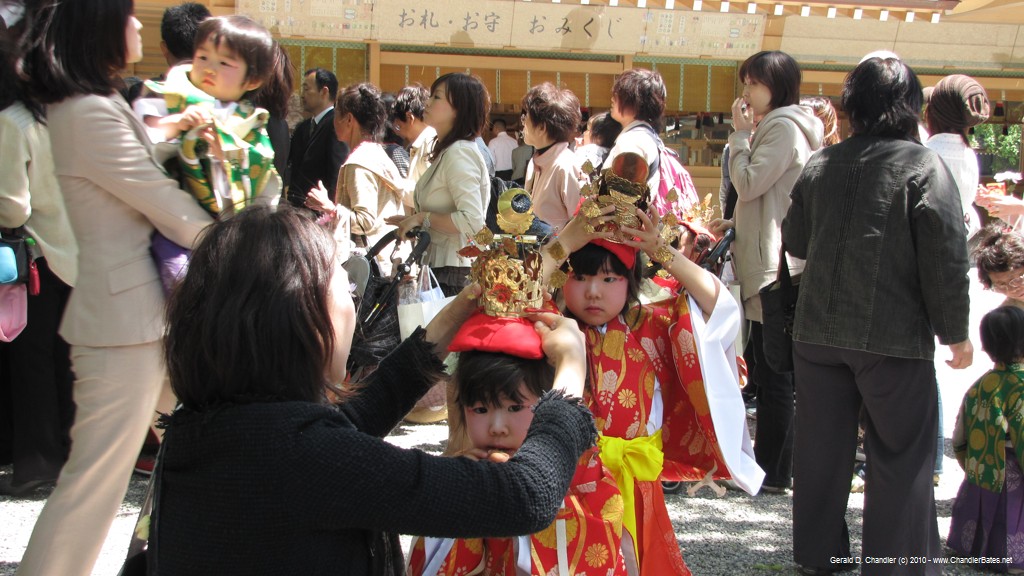
Two of the girls initiated at Atsuta |
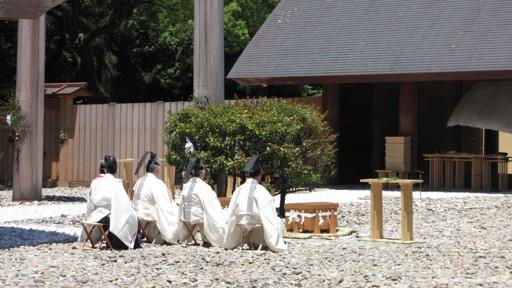
Atsuta Priests |
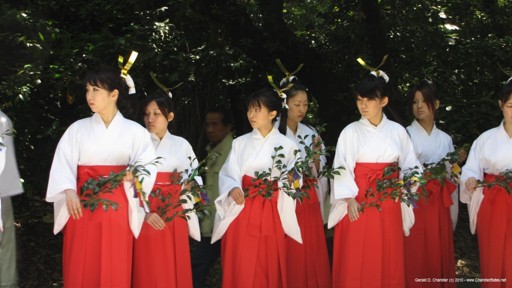
Atsuta Attendants |
Another serendipitous event gave us the chance to see and be impressed by another aspect of Japanese culture. We'd been told that the most interesting religious place to visit was the Atsuta Shrine. To get there we took a bus far across town one afternoon early in our stay; while looking around we watched a video of various Shinto celebrations that occur during the year. One of them seemed to be scheduled in early April, so Gerry found someone who spoke some English and he told us that this year's version of the ceremony would take place in two days time. We made sure we were there.
We got to watch a very colorful ceremony in which Japanese children, two to five-years old, are initiated into the ritual of the religion. The priests were dressed in flowing white robes and were crowned by traditional black head gear. The children, however, all get dressed up in pseudo samurai costumes and kimonos and all look so pretty. We heard that a fine example can run into thousands of dollars. The children and their families are invited into the first courtyard of the off-limits part of the shrine complex, while spectators like us get to watch from behind a wooden fence. We managed to find pretty good spots and got a clear view of most of the ceremony. Once the ceremony was over, there was a small celebration that included the distribution to all of the women of a lucky towel. Someone had spotted Jan in the group of spectators and pulled her forward and made a great show of presenting her with a towel. She made her very best bow and said "Arigato gozaimasu" in her very best Japanese. That brought a shower of questions in Japanese that of course she could neither understand nor answer. But there were smiles all around.
Helpful Nagoyans
It seems to us that the real test of a city's welcome is what happens when something goes wrong. In Nagoya, the something that went wrong was getting off a bus and leaving a small package behind. It was about 4 p.m. and we had been at a museum and had bought a small souvenir. We tried to run after the bus, but it quickly disappeared from view. Uncertain what to do we looked around for a bus office and they sent us to the tourist office in the basement of the same building. The lovely lady in charge, could not have been more helpful. She spoke to several people at the bus company and after a long conversation told us to go back to our hostel and that someone would contact us there with news of our lost item.
We were a little sceptical, but went back to our hostel and told the person at the desk that we might get a phone call. Two hours later, after we had completely forgotten about the matter, a knock on the door summoned us down to the front desk. There, the hostel owner very patiently translated the good news for us. The item had been found and was safe in the bus depot. All we had to do was go there the next day after ten a.m. The depot, however, was a long way out of town and it took lots of questions back and forth before we understood how to get there. Both the bus company employee and our desk clerk were endlessly patient. The next day, we found the bus depot following the instructions and were there presented with our small package. Before letting us go, the bus clerk asked how we had come and offered to refund our bus ride! That was not necessary, because of course we had a day pass rather than individual ride tickets. But truly Nagoya deserves five-star ratings for how they treat their tourists.